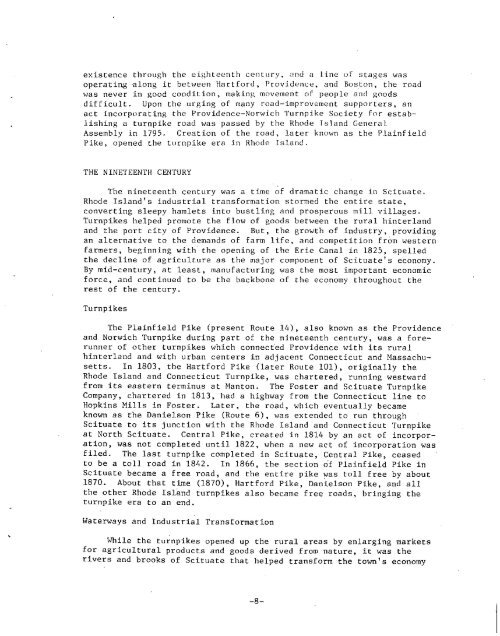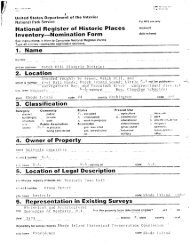Scituate - Rhode Island Historical Preservation & Heritage ...
Scituate - Rhode Island Historical Preservation & Heritage ...
Scituate - Rhode Island Historical Preservation & Heritage ...
Create successful ePaper yourself
Turn your PDF publications into a flip-book with our unique Google optimized e-Paper software.
existence through the eighteenth century, and a line oF stage.. was<br />
operating along it between Hartford, Providence, and Boston, the road<br />
was never in good condition, making movement of people and goods<br />
difficult. Upon the urging of many road-improvement supporters, an<br />
act incorporating the Providence-Norwich Turnpike Society for establishing<br />
a turnpike road was passed by the <strong>Rhode</strong> Tsland General<br />
Assembly in 1795. Creation of the road, later known as the Plainfield<br />
Pike, opened the turnpike era in <strong>Rhode</strong> <strong>Island</strong>.<br />
THE NINETEENTH CENTURY<br />
The nineteenth century was a time of dramatic change in <strong>Scituate</strong>.<br />
<strong>Rhode</strong> <strong>Island</strong>’s industrial transformation stormed the entire state,<br />
converting sleepy hamlets into bustling and prosperous mill villages.<br />
Turnpikes helped promote the flow of goods between the rural hinterland<br />
and the port city of Providence. But, the growth of industry, providing<br />
an alternative to the demands of farm life, and competition from western<br />
farmers, beginning with the opening of the Erie Canal in 1825, spelled<br />
the decline of agriculture as the major component of <strong>Scituate</strong>’s economy.<br />
By mid-century, at least, manufacturing was the most important economic<br />
force, and continued to be the backbone of the economy throughout the<br />
rest of the century.<br />
Turnpikes<br />
The Plainfield Pike present Route 14, also known as the Providence<br />
and Norwich Turnpike during part of the nineteenth century, was a fore<br />
runner of other turnpikes which connected Providence with its rural<br />
hinterland and with urban centers in adjacent Connecticut and Massachu<br />
setts. In 1803, the Hartford Pike later Route 101, originally the<br />
<strong>Rhode</strong> <strong>Island</strong> and Connecticut Turnpike, was chartered, running westward<br />
from its eastern terminus at Manton. The Foster and <strong>Scituate</strong> Turnpike<br />
Company, chartered in 1813, had a highway from the Connecticut line to<br />
Hopkins Mills in Foster. Later, the road, which eventually became<br />
known as the Danielson Pike Route 6, was extended to run through<br />
<strong>Scituate</strong> to its junction with the <strong>Rhode</strong> <strong>Island</strong> and Connecticut Turnpike<br />
at North <strong>Scituate</strong>. Central Pike, created in 1814 by an act of incorpor<br />
ation, was not completed until 1822, when a new act of incorporation was<br />
filed. The last turnpike completed in <strong>Scituate</strong>, Central Pike, ceased<br />
to be a toll road in 1842. In 1866, the section of Plainfield Pike in<br />
<strong>Scituate</strong> became a free road, and the entire pike was toll free by about<br />
1870. About that time 1870, Hartford Pike, Danielson Pike, and all<br />
the other <strong>Rhode</strong> <strong>Island</strong> turnpikes also became free roads, bringing the<br />
turnpike era to an end.<br />
Waterways and Industrial Transformation<br />
While the turnpikes opened up the rural areas by enlarging markets<br />
for agricultural products and goods derived from nature, it was the<br />
rivers and brooks of <strong>Scituate</strong> that helped transform the town’s economy<br />
-8-















